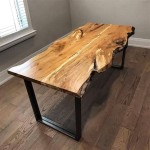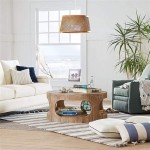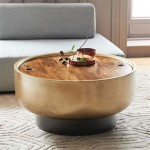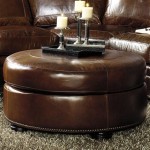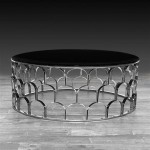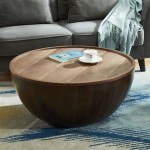Types of Tables in Restaurants: A Comprehensive Guide
The selection of tables in a restaurant is a crucial design element that significantly impacts customer experience, operational efficiency, and overall ambiance. The right table configuration can enhance comfort, optimize space utilization, and contribute to the restaurant's aesthetic appeal. A variety of table types cater to different dining styles, group sizes, and spatial constraints. Understanding these options is essential for restaurant owners and designers aiming to create a welcoming and functional environment.
Standard Dining Tables
Standard dining tables are the most common type found in restaurants. These tables are typically rectangular or square and designed to accommodate two to four diners. Rectangular tables often feature a length that allows diners to sit across from each other comfortably, fostering conversation and a shared dining experience. Square tables offer a more intimate setting, ideal for couples or small groups seeking a closer interaction.
The dimensions of standard dining tables vary but generally adhere to a set of accepted norms. A typical rectangular table for two individuals might measure approximately 30 inches wide and 48 inches long. For four people, a table measuring 48 inches wide and 48 inches long or 30 inches wide and 72 inches long is often preferable. Square tables designed for two people are usually around 30 inches by 30 inches, while those for four people may be 48 inches by 48 inches.
These tables are often constructed from a variety of materials, including wood, metal, and engineered composites. Wood tables offer a classic and warm aesthetic, while metal tables provide a more modern and industrial look. Engineered composites, such as laminate or resin, offer durability and ease of maintenance, making them a practical choice for high-traffic restaurants. The choice of material depends on the restaurant's desired ambiance, budget, and operational requirements.
The leg design of standard dining tables can also vary widely. Common options include four legs, pedestal bases, and trestle supports. Four-legged tables provide stability and a familiar look, while pedestal bases offer more legroom and a cleaner aesthetic. Trestle supports add a rustic or farmhouse-inspired touch to the dining space.
Communal Tables
Communal tables, also known as harvest tables or sharing tables, are large, often rectangular tables designed to seat multiple parties at once. These tables encourage interaction and create a sense of community among diners. They are particularly popular in casual dining establishments, breweries, and restaurants aiming to foster a social atmosphere.
Communal tables are significantly larger than standard dining tables, typically accommodating six to twenty or more diners. Their dimensions can vary widely depending on the available space and the desired seating capacity. A common size for a communal table might be 36 inches wide and 8 to 10 feet long, offering ample space for multiple groups to dine comfortably.
These tables are often constructed from solid wood, contributing to their robust appearance and inviting atmosphere. Reclaimed wood is a popular choice, adding a sustainable and characterful element to the restaurant's design. Metal accents, such as steel legs or support brackets, can add an industrial touch and enhance the table's durability.
The seating arrangement at communal tables typically involves benches or individual chairs placed along both sides of the table. Benches offer a more casual and communal experience, while chairs provide individual comfort and flexibility. The choice between benches and chairs depends on the restaurant's target demographic and desired atmosphere.
Communal tables can be strategically placed in a restaurant to encourage interaction among diners who might not otherwise interact. They are particularly effective in creating a lively and energetic atmosphere, making them a popular choice for restaurants seeking to cultivate a social dining experience. They can also be useful in maximizing seating capacity in smaller spaces.
Booth Seating
Booth seating offers a more private and comfortable dining experience compared to standard tables. Booths typically consist of upholstered benches or seats arranged along a wall, creating a semi-enclosed space for diners. They are popular in a variety of restaurant settings, offering a mix of privacy and comfort that appeals to many customers.
The configuration of booths can vary, but they typically accommodate two to six diners. A common booth arrangement involves two benches facing each other across a table, with a high backrest providing a sense of enclosure. U-shaped booths, which wrap around three sides of the table, are also popular, offering a more intimate and conversational setting.
The dimensions of booths depend on the seating capacity and the overall design. A typical booth for four people might measure approximately 48 inches wide and 48 inches deep, with a bench height of around 18 inches. The backrest height can vary, but it is typically around 36 to 48 inches, providing ample support and privacy.
Booth seating is often constructed with a combination of wood and upholstery. The frame and structure of the booth are typically made from wood, providing durability and stability. The benches and backrests are usually upholstered in fabric, leather, or vinyl, offering comfort and visual appeal. The choice of upholstery material depends on the restaurant's style, budget, and maintenance requirements.
Booth seating can be customized to suit the restaurant's specific design aesthetic. The shape, size, and upholstery of the booths can be tailored to match the overall theme and create a cohesive look. Booths can also be incorporated into other design elements, such as walls or partitions, to create a more integrated and visually appealing space.
High-Top Tables
High-top tables, also known as bar tables or pub tables, are elevated tables typically paired with stools or high chairs. They are common in bars, pubs, and casual dining establishments, offering a more informal and social dining experience. High-top tables are often used for quick meals, drinks, or socializing.
High-top tables are typically smaller than standard dining tables, accommodating two to four diners. Their dimensions vary, but a common size might be 30 inches in diameter for a round table or 30 inches by 30 inches for a square table. The height of high-top tables is typically around 40 to 42 inches, allowing diners to sit comfortably on stools or high chairs.
These tables are often constructed from a variety of materials, including wood, metal, and glass. Wood tabletops offer a warm and inviting look, while metal tabletops provide a more modern and industrial feel. Glass tabletops can add a touch of elegance and sophistication to the dining space.
The base of high-top tables can vary, with options including pedestal bases, four legs, and decorative supports. Pedestal bases are a popular choice, offering stability and a clean aesthetic. Four-legged tables provide a more traditional look, while decorative supports can add a unique and stylish touch.
High-top tables are often placed in areas where space is limited or where a more casual atmosphere is desired. They can be used to create a bar area, a waiting area, or a casual dining space. They are also effective in maximizing seating capacity in smaller restaurants or bars.
Outdoor Tables
Outdoor tables are specifically designed to withstand the elements and provide a comfortable dining experience in outdoor settings. These tables are typically constructed from durable materials that can resist weather damage, such as rain, sun, and wind. They are an essential component of restaurants with patios, decks, or other outdoor dining areas.
The size and shape of outdoor tables vary depending on the available space and the desired seating capacity. Common shapes include rectangular, square, and round tables. Rectangular and square tables are often used for larger groups, while round tables are ideal for smaller groups or couples.
Outdoor tables are typically constructed from materials such as aluminum, steel, teak, and recycled plastic. Aluminum and steel are lightweight and rust-resistant, making them ideal for outdoor use. Teak is a durable and weather-resistant hardwood that offers a natural and elegant look. Recycled plastic is an environmentally friendly option that is resistant to moisture and fading.
The design of outdoor tables should complement the restaurant's overall aesthetic and blend seamlessly with the surrounding environment. Tables can be adorned with umbrellas, tablecloths, or other decorative elements to enhance the dining experience. Comfortable seating, such as outdoor chairs or benches, is essential for creating a welcoming and enjoyable outdoor dining space.
Proper maintenance is crucial for ensuring the longevity of outdoor tables. Regular cleaning and protective treatments can help prevent weather damage and maintain the tables' appearance. Storing outdoor tables indoors during harsh weather conditions can further extend their lifespan.
Adjustable Height Tables
Adjustable height tables offer versatility and adaptability, allowing restaurants to accommodate a variety of diners and needs. These tables can be adjusted to different heights, making them suitable for wheelchair users, children, or those who prefer to stand while dining. Adjustable height tables are particularly useful in restaurants that cater to a diverse clientele.
The mechanism for adjusting the height of these tables can vary, with options including manual cranks, gas springs, and electric motors. Manual cranks are a simple and cost-effective option, while gas springs offer smoother and easier adjustments. Electric motors provide the most convenient and precise height adjustments.
Adjustable height tables are typically constructed from durable materials such as steel, aluminum, and wood. The tabletop can be made from a variety of materials, including laminate, wood veneer, or solid wood. The base of the table is usually made from steel or aluminum, providing stability and durability.
These tables can be incorporated into a variety of restaurant settings, including dining rooms, bars, and patios. They can be used as standard dining tables, high-top tables, or even standing tables. Adjustable height tables offer a flexible and adaptable solution for restaurants seeking to accommodate a wide range of customer needs.
Folding Tables
Folding tables are a practical and space-saving solution for restaurants with limited storage space or those that require flexible seating arrangements. These tables can be easily folded and stored when not in use, making them ideal for temporary events, overflow seating, or outdoor dining areas that need to be cleared regularly.
Folding tables are typically constructed from lightweight and durable materials such as plastic, aluminum, and steel. The tabletop is often made from plastic or laminate, providing a smooth and easy-to-clean surface. The legs are usually made from steel or aluminum, providing stability and support.
These tables are available in a variety of sizes and shapes, including rectangular, square, and round. They can be used as standard dining tables, buffet tables, or catering tables. Folding tables are a versatile and cost-effective solution for restaurants that need to quickly and easily adjust their seating capacity.
The folding mechanism of these tables can vary, with options including simple folding legs, hinged tabletops, and collapsible frames. The choice of folding mechanism depends on the table's size, weight, and intended use. Folding tables should be easy to set up and take down, minimizing the time and effort required to adjust the seating arrangement.

The Complete Guide To Dining Tables Types And Styles Cabinfield Blog

Restaurant Tables Cost Guide World Coppersmith

The Complete Guide To Dining Tables Types And Styles Cabinfield Blog

The Complete Guide To Dining Tables Types And Styles Cabinfield Blog

Restaurant Tables Guide Materials Durability Aesthetics
59466501-299e-45da-bc7d-e5a971e8324b.webp?strip=all)
Hospitality Table Size Guide

Restaurant Table Sizes Dimensions Seating Capacity Guide

How Many Types Of Restaurant Tables Are Available

10 Types Of Wood Tables For Each Restaurant Style Furniture Plus

10 Popular Restaurant Table Designs In
Related Posts

